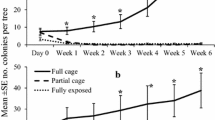Abstract
Metaseiulus occidentalis (Nesbitt) andTyphlodromus pyri Scheuten have complementary features/ traits that enable them to control effectively plant-feeding mites on apple. Populations of both predators gave as good or better biological control of the apple rust mite (Aculus schlechtendali Nalepa), European red mite (Panonychus ulmi Koch) and two-spotted spider mite (Tetranychus urticae (Koch)) than single-predator populations. With mixed predators,M. occidentalis provided better control of spider mites the first season after release, butT. pyri gave better control in the second season. Several factors affected the ability of predators to provide biological control: When prey were dense,M. occidentalis rapidly increased during the warm mid-summer, whileT. pyri provided greater predation when it was cool at the start or end of the growing season. When few prey were present, searching byM. occidentalis was more confined on individual apple leaves, but it migrated between leaves and trees more often. Pollen feeding, cannibalism and interspecific predation were more common byT. pyri. In fall, oviposition byM. occidentalis stopped sooner and in the following spring,T. pyri reproduced beforeM. occidentalis. Research needs and management of mixed-predator populations are discussed.
Similar content being viewed by others
References
Bower, C.C. and Thwaite, W.G., 1989. The mite management manual: a practical guide to integrated mite control. N.S.W. Australia Agric. & Fish. Bull., 56 pp.
Bruce-Oliver, S.A. and Hoy, M.A., 1990. Effect of prey stage on life-table attributes of a genetically manipulated strain ofMetaseiulus occidentalis (Acari: Phytoseiidae). Exp. Appl. Acarol., 9:201–217.
Croft, B.A., 1970. Comparative studies on four strains ofTyphlodromus occidentalis Nesbitt (Acarina: Phytoseiidae). I. Hybridization and reproductive isolation studies. Ann. Entomol. Soc. Am., 63: 1528–1531.
Croft, B.A., 1990. Arthropod Biological Control Agents and Pesticides. Wiley, New York, NY, 723 pp.
Croft, B.A. and Hull, L.A., 1983. The orchard as an ecosystem. In: B.A. Croft and S.C. Hoyt (Editors), Integrated Management of Insect Pests of Pome and Stone Fruits. Wiley Intersci., New York, NY, pp. 19–42.
Croft, B.A. and MacRae, I.V., 1992. Biological control of apple mites by mixed populations ofMetaseiulus occidentalis andTyphlodromus pyri (Acari: Phytoseiidae). Environ. Entomol., 21: 202–209.
Croft, B.A., Riedl, H.W., Shearer, P. and Fields, G.J., 1990. Distribution ofMetaseiulus occidentalis (Nesbitt) andTyphlodromus pyri Scheuten in apple orchards of the Hood River Valley, Oregon. Can. Entomol., 122: 5–14.
Dicke, M. and DeJong, M., 1988. Prey preference of the phytoseiid miteTyphlodromus pyri: an electrophoretic analysis. Exp. Appl. Acarol., 4: 15–25.
Dicke, M., Sabelis, M.W. and DeJong, M., 1988. Analysis of prey preference in phytoseiid mites by using an olfactometer, predation models and electrophoresis. Exp. Appl. Acarol., 5: 225–242.
Doutt, R.L. and DeBach, P., 1964. Some biological control concepts and questions. In: P. Debach (Editor), Biological Control of Insect Pests and Weeds. Reinhold New York, NY, pp. 118–139.
Dunley, J.E. and Croft, B.A., 1990. Dispersal between and colonization of apple byMetaseiulus occidentalis andTyphlodromus pyri (Acarina: Phytoseiidae). Exp. Appl. Acarol., 10: 137–149.
Dunley, J.E. and Croft, B.A., 1992. Dispersal and gene flow of pesticide resistance traits in phytoseiid and tetranychid mites. Exp. Appl. Acarol., 14: 313–325.
Hadam, J.J., AliNiazee, M.T. and Croft, B.A., 1986. Phytoseiid mites (Parasitiformes: Phytoseiidae) of major crops in the Willamette Valley, Oregon and pesticide resistance inTyphlodromus pyri Scheuten. Environ. Entomol., 15: 1255–1262.
Helle, W. and Sabelis, M.W., 1985. Spider Mites: Their Biology, Natural Enemies and Control, Vol. 1B. Elsevier, Amsterdam, 458 pp.
McMurtry, J.A., Huffaker, C.B. and van de Vrie, M., 1970. Ecology of tetranychid mites and their natural enemies: A review. I. Tetranychid enemies: their biological characters and the impact of spray practices. Hilgardia, 40: 331–390.
Penman, D.R., Wearing, C.H., Collyer, E. and Thomas, W.P., 1979 The role of insecticide-resistant phytoseiids in integrated mite control in New Zealand. Rec. Adv. Acarol., 1: 59–69.
Van de Vrie, M., McMurtry, J.A. and Huffaker, C.B., 1972. Ecology of tetranychid mites and their natural enemies: A review. III. Biology, ecology and pest status, and host-related relatins of tetranychids. Hilgardia, 41: 343–432.
Westigard, P.H., Medinger, L.E. and Kellogg, O.E., 1972. Field evaluation of pesticides for their suitability in an integrated program for spider mites on pear. J. Econ. Entomol., 65: 191–192.
Author information
Authors and Affiliations
Rights and permissions
About this article
Cite this article
Croft, B.A., MacRae, I.V. & Currans, K.G. Factors affecting biological control of apple mites by mixed populations ofMetaseiulus occidentalis andTyphlodromus pyri . Exp Appl Acarol 14, 343–355 (1992). https://doi.org/10.1007/BF01200572
Issue Date:
DOI: https://doi.org/10.1007/BF01200572




